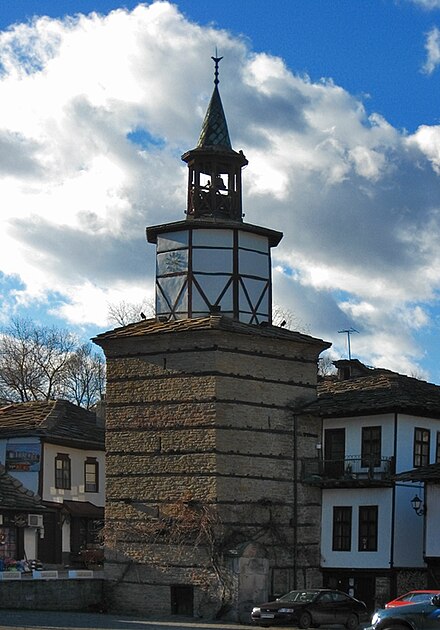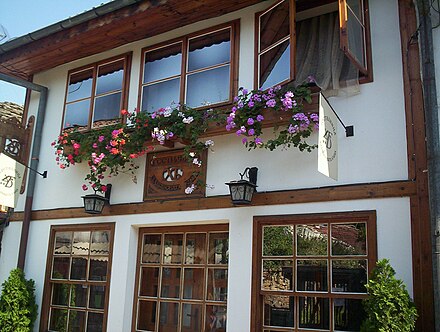Tryavna - town in Bulgaria
Tryavna is a town in the region of the Balkan in Bulgaria.
Understand
 Tryavna (Bulgarian: Трявна) is a town in central Bulgaria in the north slopes of the Balkan range, on the Tryavna river valley, near Gabrovo. It is famous for its textile and crafts industry and typical National Revival architecture, featuring 140 cultural monuments, museums and expositions. Tryavna is the birthplace of Bulgarian writer Pencho Slaveykov and revolutionary Angel Kanchev.
Tryavna (Bulgarian: Трявна) is a town in central Bulgaria in the north slopes of the Balkan range, on the Tryavna river valley, near Gabrovo. It is famous for its textile and crafts industry and typical National Revival architecture, featuring 140 cultural monuments, museums and expositions. Tryavna is the birthplace of Bulgarian writer Pencho Slaveykov and revolutionary Angel Kanchev.
The location has been inhabited since Thracian times, or for thousands of years, but the earliest definitive proof of the existence of the modern village dates to the 12th century, in the years around the conquest of the Second Bulgarian Kingdom by the Ottoman Turks. During the period of Bulgarian National Revival, when Bulgarian society redefined itself in the 18th and 19th centuries during the Ottoman occupation, the town became heavily involved in the development of crafts. Houses from this period feature their own architectural design. The ground floors had irregular forms and housed craftsmen and traders. The upper floors featured wooden bow-windows, the roofs were covered with well arranged rocks.
Climate
The city has a continental climate, owing to its position close to the Balkan Mountains and distance from the Black Sea. Tryavna has hot summers and cold, snowy winters — which is good for the popular sky resorts in the nearby Uzana area. This part of Bulgaria has all four seasons, although spring is brief and falls mainly in April. The average high daily temperature in summer is about 27°C and in winter about 4°C.
Get in
 The town is well connected with the whole country thanks to its excellent road network and railway station.
The town is well connected with the whole country thanks to its excellent road network and railway station.
By car
The town is on Route 609 and Route 552, which are the same road when they pass through Tryavna. Highway 55, running north-south, passes the town to the east and Highway 5 passes the village to the west.
By bus
A regular daily bus connect Tryavna with Sofia, though it runs only once a day. A bus runs back and forth from Tryavna to Gabrovo about 10 times a day during the week, and about half as often during the weekend.
By train
Tryavna is on a major north-south railway line and there are several trains from the major transport hub of Gorna Oryahovitsa, next to the historic town of Veliko Turnovo. From there, changes to trains from Sofia can be done. A few trains continues southwards to Stara Zagora and Dimitrovgrad. In the other direction, there are connections to Tryavna from theRuse, on the border with Romania. Additionally, the once-daily overnight train between Bucharest and Istanbul also calls here. Tickets and timetables are available at stations or at the website of national operator BDZ.
- Tryavna railway station, 42.873278°, 25.496836°. 2019-09-08
Get around
The town has its own small bus system, some taxis and marshrutkas. However, it is a comparatively small community and most of the historical and interesting areas are close enough to each other to be accessed on foot.
See
- Museum of Icon-Painting and Wood-Carving (Музеят на иконописта и дърворезбата), No. 1, Breza Str., 42.866885°, 25.482077°, +359 896 755 938. Winter: 08:30 - 16:309; summer: 10:00 - 18:00. The museum treasures the only collection of Tryavna icons from the 17th to the turn of the 19th century. Over 160 original icons represent the creative output of the six renowned families of icon-painters. 2019-09-08
- Angel Kanchev Museum-House (Ангел Кънчев Къщата-музей), No. 39, Angel Kunchev Str. (39 ул. Ангел Кънчев.), 42.868418°, 25.493837°, +359 896 755 935. Closed in winter; summer: 09:30-13:30 and 14:00-18:00. Documents and domestic life exhibits follow the life and revolutionary work of Angel Kunchev, the struggle of the townspeople to break the shackles of the Turkish Yoke as well as the participation of the town in the Russian-Turkish War of Liberation (1877-1878). 2019-09-08
- The Clock Tower and Old Bridge (Часовниковата кула и стария мост), 42.866260°, 25.489202°. No closed hours.. The Clock Tower was built in 1814 and the clock installed in 1815, which still functions. No fee required 2019-09-08
- St. Archangel Michael Church (Св. Архангел Михаил), No. 128 Angel Kunchev Str. (128 ул. Ангел Кънчев), 42.866467°, 25.490454°, +91-22-2222-1234. An exceptionally valuable monument of culture dating back to the Middle Ages; it keeps an old cross with 12 scenes from the Bible wood-carved on it; the church iconostasis and the bishop's throne have been recognized as masterpieces of the Tryavna school of woodcarving. 2019-09-08
Do
A historical village and architectural preserve - the old buildings are maintained - Tryavna offers a lot to sight seers, photographers, people who enjoy shopping and similar activities. The town is also home to a number of galleries and museums, which art and artifacts from across the history of Bulgaria.
Buy
Tryavna offers a profusion of shopping opportunities, many of which cater to tourists, including shops selling sojourners, clothings, jewelry, arts and craft items and similar goods.
- Art-M Gallery (Арт-М галерия), Address (20 ул. Ангел Кънчев), +359 677 624 92. Paintings, icons, small sculpture pieces and souvenirs.
- Gabi Company (Габи Дружеството), No. 50 Angel Kanchev Str. (50 ул. Ангел Кънчев), +359 887 348 163, office@gabi-jewellery.com. Unique handmade jewelry.
- Pavel Pavlov Craft Enterprise (Павел Павлов занаятите), No. 9 V. Mihalev Str. Fl. 3 Ap.10 (No. 9 ул. В. Михалев Str. Етаж 3 Апартамент 10), +359 895 121 861. Art processing of wood and specialized manufacture of wooden toys.
- Peter Shterev (Петър Щерев), No. 13 Zdravets Str. (13 ул. Здравец), +359 897 960 431, galinaartsuveniri@abv.bg. A master of traditional Bulgarian dance shoes for dances and souvenirs.
Eat

- Kalincheva House Restaurant (Kalincheva Къща ресторант), No. 45 P. R. Slaveikov Str. (45 ул. П. Р. Славейков) (near the center of town), +359 6776 2024, kalincheva-house@tryavna.biz. This restaurant, which serves traditional Bulgarian food, is located in the old part of the town and represents a preserved house from the National Revival Period, dating back from 1830.
- Old Vine Restaurant (Старата Лоза ресторант), No. 44 P. R. Slaveikov Str. (44 ул. П. Р. Славейков) (near the center of town), +359 677 64501, starata-loza@tryavna.biz. Country-style atmosphere, traditional Bulgarian food, summer garden.
- Tryavna Beer House (Бирария Трявна), No. 7 Angel Kanchev Str. (7 ул. (near the center of town), +359 677 63727, belinvest@abv.bg. This establishment is a meeting place for real beer and cuisine connoisseurs. They make beer from natural Belgian products and traditional Belgian recipes and technologies.
Drink
Drinking establishments are common in Bulgaria and Tryavna. Beer and alcohol are available at almost all coffee shops, restaurants and shops where food and refreshments are available. There are few establishments which serve only alcohol.
Sleep
- Art-M Hotel, 20 Angel Kanchev St (near the center of town), +359 6776 2492. Home to an art gallery, a cafeteria and a number of comfortable hotel rooms.
- Brashlyan Hotel Complex, 6 Panorama St (at the edge of town), +359 6776 3019. Two-room apartments, one-room apartments, luxurious apartments and one-family houses situated closely to the hotel, amidst a grove of pine trees. The hotel also includes a restaurant, terrace over-looking the town, barbecue, conference hall, night bar and recreation center.
- Complex Harmony Hotel, 54 Hristo Botev St (at the edge of town), +359 6776 2460. Coffee shop and restaurant, wireless Internet connection, a swimming pool and a summer garden.
- Hilez Hotel, 17 Stara Planina St (near the center of town), +359 6776 6920. 24 double rooms, lobby bar and tavern with 100 seats.
Go next
Hiking, biking and camping opportunities are widely available in the nearby Central Balkan National Park (dead link: October 2017) and in the Nature Park Bulgarka, itself home to Ethnographic Complex Etara, Dryanovo Monastery, Sokolski Monastery, Shipka Pass, and the Uzana area. The Bozhentsi Trail (Екопътека Боженци - Дряновски манастир) leads to the village and the Dryanovo Monastery.
Tryavna
tryavna.bgObshtina Tryavna
2nd-order administrative division
Gabrovo
Primary administrative division